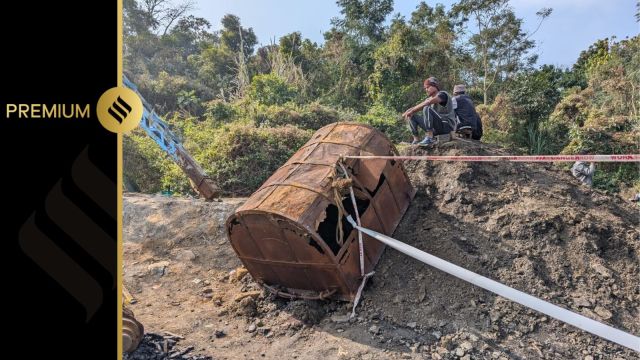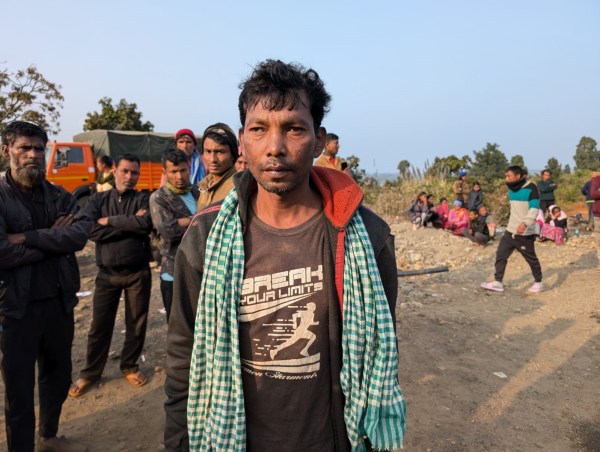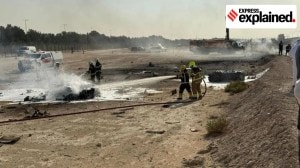From Assam, a rathole miner’s tale of survival: ‘Men scrambled out of tunnels and were swept into each other’
As the water rose rapidly, people clung to whatever they could find: the wall, the pipe of the water pumping machine, and the crane’s chain.
 The labourers were on Monday trapped inside the 3-Kilo Coal Quarry in Umrangso area, around 250 km from Guwahati, after a sudden gush of water flooded the site. The photo shows the box in which survivors were pulled out. (Express photo)
The labourers were on Monday trapped inside the 3-Kilo Coal Quarry in Umrangso area, around 250 km from Guwahati, after a sudden gush of water flooded the site. The photo shows the box in which survivors were pulled out. (Express photo)When Rajeev Barman, 39, entered the ill-fated mine in Umrangso’s coal reserves at
4:30 am on Monday with three others he was sharing a room with, he was hungry for work. He had been making several rounds to the coal reserves for the last month-and-a-half, but all work was on hold because of water in the mine.
So, when their “sardar (head)” finally told them the previous night that work could begin in the mine since the water had been pumped out, Barman was relieved. Little did he know that he would be the only one from his room to make it out alive.
On Monday, the rathole mine in Assam’s Dima Hasao district was flooded, trapping several men, including Barman and his roommates Khusi Mohan Rai, Sarpa Barman and Sanjit Sarkar. While Barman, a resident of Assam’s Kokrajhar district, is among 25-odd miners who were rescued in time by other workers and supervisors, one person’s body has been retrieved, and at least eight — including Barman’s three roommates — continue to be missing.
 Joseph Soren, a 40-year-old miner from Assam’s Chirang district
Joseph Soren, a 40-year-old miner from Assam’s Chirang district
The four of them were working in one of the tunnels — or rat holes — branching out from the bottom of the 310-foot-deep central pit of the mine when the incident occurred. He said they had gone around 250 feet into one of the rat holes that morning. Two hours into work there, they heard screaming.
“Because we had worked after such a long time, our arms were hurting and we were tired so we decided to stop and go back early. Just then, we heard people from another tunnel shouting that ‘water is coming’, and could hear the sound of water gushing. We immediately started rushing towards the centre,” he told The Indian Express.
 Divers from the Special Forces who retrieved the body told The Indian Express that the first challenge was the depth of the water – approximately 100 feet – inside the 310-feet deep central pit of the mine, and the complete lack of visibility. (Express Photo)
Divers from the Special Forces who retrieved the body told The Indian Express that the first challenge was the depth of the water – approximately 100 feet – inside the 310-feet deep central pit of the mine, and the complete lack of visibility. (Express Photo)
In the pitch-darkness of rat holes — around 2 to 3 metres in height — miners have to crawl, their path illuminated by a torch tied to their head with a cloth, carrying picks and shovels and with a cart to haul the coal they have mined. After crawling 200 feet in the tunnel, the group encountered gushing water.
“We took off our shoes to make it easier for us to move and we rushed to the centre… the water was already reaching our chest,” he said.
Joseph Soren, a 40-year-old miner from Assam’s Chirang district, was at the central pit when the flooding began. His role was to load the mined coal into two boxes at the bottom of the pit, which were then lifted out one at a time by a crane. He was on box 11 when a fellow miner came rushing out from one of the tunnels and jumped onto a box. Soon, gushing water followed.
“The water flow was so strong that some people coming out of one tunnel were being swept into another one,” he said.
Then came the desperate scramble to leave the mine as workers began rushing out of different tunnels. In desperation, they wrestled each other to get onto a box and be lifted out of the mines. In the chaos, the lock attaching the box to the crane’s chain pulley fell into the water and was lost.
As the water rose rapidly, people clung to whatever they could find: the wall, the pipe of the water pumping machine, and the crane’s chain. About a dozen clung to the chain and tried to climb it. Barman was one of them.
“Around 10-15 of us were clinging to the chain, one on top of another, and people outside had in the meantime realised what happened. They started lifting us with the crane. But after it rose a few feet, there was a jerk and we fell into the water. Only two managed to hold on and got out of the mine,” he said.
The water was acrid, burning their eyes. According to Jalalludin, 27, another miner who was not at work that day, the boxes were submerged by then, so workers above ground attached a broken box to the crane and lowered it. It was on this box that over 20 workers were lifted out in four rounds, among them Barman and Soren.
Safe and above ground now, the men waited in their camps around the mine for their fellow miners to be pulled out. Jalalludin, a resident of Assam’s Darrang district who has worked in mines like this in Meghalaya for the last eight years, was one of them.
The work is dangerous, he said, but it pays better than other daily wage work: Rs 200 for every cart of coal they mine.
Most miners manage 10-15 carts on an average day.
“I know that there is a lot of risk in this, but we do it. We are poor and oppressed, and this pays better than any daily wage work we can get in our villages, which can be at the most Rs 450 a day,” he said.
Despite the dangers, Barman believes the work is as risky as any other job.
“For example, even being a driver comes with the risk of accidents. But I have escaped death and been given a second life now. I will not be going back to a mine, even if I earn only Rs 250 in a day working in the village,” he said.



- 01
- 02
- 03
- 04
- 05




























